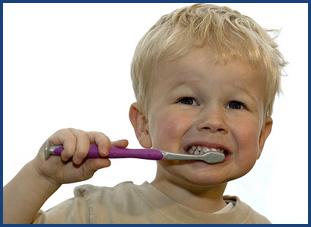Call (800) SMILING • (800) 764-5464 • (425) 483-2442
Send Us an Email
Advanced Care Dentistry
13515 NE 175th Suite B Woodinville, WA 98072 (800) SMILING (800) 764-5464 (425) 483-2442
Dentists: Thomas O. Marxen, DDS, MSD. Erica Yang, DDS.
First Visit to the Dentist

My Child's First Visit to the Dentist
It's recommended that you bring your baby in for a visit within six months of the first tooth's eruption – usually around his/her first birthday. Since decay can occur in even the smallest of teeth, the earlier your baby visits us, the more likely he/she is to avoid problems. We'll look for any signs of early problems with your baby's oral heath, and check in with you about the best way to care for his/her teeth. Remember that preparing for each dental visit with a positive attitude goes a long way toward making your child comfortable with regular checkups.
A child's first visit to the dentist should be enjoyable and positive. The more you and your child know about the first visit, the better you will feel. Children are not born with a fear of the dentist, but they can fear the unknown. We want you to feel at ease from the moment your family arrives at our office. In most cases, we focus on getting to know your child and giving you some basic information about dental care. We will attempt to take a quick look into your child's mouth and if possible do a bit of cleaning. We will also answer any questions you have about how to care for your child's teeth as they develop, and provide you with material containing helpful tips that you can refer to at home.
How often should my child visit the dentist?
We generally recommend scheduling checkups every six months. Depending on the circumstances of your child's oral health, we may recommend more frequent visits.
When New Teeth Arrive
Your child's first tooth erupts between ages 6-12 months and the remainder of the 20 primary or "baby" teeth typically erupt by age 3. During this time, gums may feel tender and sore, causing your child to feel irritable. To help alleviate this discomfort, we recommend that you soothe the gums by rubbing a clean finger or a cool, wet cloth across them. You may also choose to make use of a teething ring.
Your child's primary teeth are shed at various times throughout childhood, and the permanent teeth begin erupting at age 6 and continue until age 21. Adults have 28 permanent teeth, or 32 including wisdom teeth.
Adopting Healthy Oral Hygiene Habits
As new teeth erupt, examine them every two weeks for lines and discoloration caused by decay. Remember that sugary foods and liquids can attack a new tooth, so take care that your child brushes his/her teeth after feeding or eating. We recommend brushing four times a day for optimal oral hygiene: after breakfast, after lunch, after dinner, and at bedtime. Brushing can be fun, and your child should brush as soon as the first tooth arrives. When a baby's tooth erupts, parents should brush the tooth with a soft-bristled toothbrush and a pea-sized amount of non-fluoridated toothpaste. We suggest reviewing proper tooth-brushing procedures with your child.
» Click here to learn how to brush your teeth.
Brushing: Step 1
Place your toothbrush at a 45 degree angle to your gum.
Brushing: Step 2
Brush gently in a circular motion.
Brushing: Step 3
Brush the outer, inner, and chewing surfaces of each tooth.
Brushing: Step 4
Use the tip of your brush for the inner surface of your front teeth.
Flossing is also a part of good oral hygiene habits, and your doctor will discuss with you the right time to start flossing.
» Click here to learn how to floss your teeth.
Flossing: Step 1
Wind about 18 inches of floss around your fingers as shown. Most of it should be wrapped around one finger, and as the floss is used, the other finger takes it up.
Flossing: Step 2
Use your thumbs and forefingers to guide about one inch of floss between your teeth.
Flossing: Step 3
Holding the floss tightly, gently saw the floss between your teeth. Then curve the floss into a C-shape against one tooth and gently slide it beneath your gums.
Flossing: Step 4
Slide the floss up and down, repeating for each tooth.
If you notice signs of decay, contact your dentist immediately.